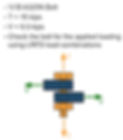Bolt Design (AISC 360)
- nick8284
- Aug 2, 2025
- 2 min read
Bolted connections are a fundamental part of structural steel design. While many connections are loaded primarily in shear or tension, combined loading is common in real-world structures — and must be addressed explicitly in design.
In this post, we highlight the key principles of bolt design under simultaneous shear and tension per the AISC 360 Specification. We’ll focus on the essential concepts that govern capacity and demonstrate how to check a bolt group for combined action.
Why Combined Loading Matters
Bolts rarely experience a single force type in isolation. Common scenarios that induce combined loading include:
Slotted or angled connections where load paths aren’t aligned
Eccentric or bracketed connections
Flange or splice plates in tension plus lateral drift
Wind or seismic-induced lateral-torsional effects
In these cases, bolts must be checked not only for individual shear and tension capacities — but for their interaction.

Key Factors in Bolt Design Under Combined Loading
1. 1. Load Identification
Begin by determining:
The factored shear force (Vu) on each bolt
The factored tensile force (Tu) on each bolt. These forces typically come from a structural model or hand calculation using LRFD combinations per ASCE 7.
2. Bolt Selection
Design capacity depends on:
Bolt type (A325, A490, etc.)
Bolt diameter
Bolt hole type (standard, oversized, short-slotted, long-slotted)
Connection category (bearing vs. slip-critical)
3. Interaction Check
When bolts are subjected to combined shear and tension, an interaction equation must be satisfied to ensure the combined demand does not exceed capacity.
4. Special Considerations
Thread condition: Whether threads are included or excluded from the shear plane affects strength values.
Slip-critical connections: Require different checks entirely and involve bolt pretension and faying surface slip resistance.
Block shear and bearing: In addition to bolt strength, surrounding steel must be checked for block shear rupture and bearing deformation.
Example Problem
(Solutions Provided Using CalcBook) Problem Statement:

Material Properties:

Demand Calculation:

Shear Capacity:

Tensile Capacity:

Demand / Capacity Ratio:

Conclusion
Combined shear and tension bolt design is a key part of structural steel engineering. While the AISC interaction check is straightforward, it’s critical to apply it properly — with the correct nominal strengths, resistance factors, and load values.
CalcBook automates this process with:
Built-in bolt databases and design tables
Full support for AISC 360 combined load checks
Clean, traceable documentation for any bolt group
👉 Try CalcBook today to streamline your steel connection design and stay code-compliant with confidence.
